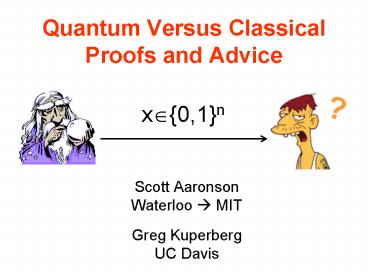Quantum Versus Classical Proofs and Advice - PowerPoint PPT Presentation
1 / 16
Title:
Quantum Versus Classical Proofs and Advice
Description:
QMA: Quantum Merlin-Arthur ... Merlin gives Arthur an explicit group , together with a claimed isomorphism f: ... Arthur checks that f is a homomorphism using ... – PowerPoint PPT presentation
Number of Views:67
Avg rating:3.0/5.0
Title: Quantum Versus Classical Proofs and Advice
1
Quantum Versus Classical Proofs and Advice
?
??
- Scott AaronsonWaterloo ? MIT
Greg KuperbergUC Davis
2
Can quantum proofs let us verify certain
theorems exponentially faster than classical
proofs? Yes (we think!) But to argue for the
power of quantum proofs, well have to introduce
a new kind of evidence Quantum Oracle
Separations (Its not just that we failed to
find the old kind of evidencewe can tell you
exactly why we failed)
3
Schrödingers Zoo
QMA Quantum Merlin-ArthurClass of problems for
which a yes answer can be verified in quantum
polynomial-time, with help from a polynomial-size
quantum witness state
QCMA Quantum Classical Merlin-ArthurSame,
except now the witness has to be classical
Closely related to quantum proofs is quantum
advice
BQP/qpoly Class of problems solvable in quantum
polynomial time, with help from a quantum advice
state ?n? that depends only on the input length
n
BQP/poly Same, except now advice has to be
classical
4
Surely it should at least be easy to separate
these classes by oracles
PP/poly
Dream on!
PP
QMA
BQP/qpoly
QCMA
BQP/poly
BQP
MA
P/poly
5
This Talk Quantum Oracle Separations
Theorem There exist quantum oracles U and V
such that QMAU ? QCMAU and BQPV/qpoly ?
BQPV/poly Quantum oracle A sequence of unitary
transformations Un that a quantum algorithm can
apply in a black-box fashion Models subroutines
that take quantum input and produce quantum
output A new kind of evidence that two complexity
classes are different Idea has already found
other applications in quantum computing A07
MS07
6
The Oracle Problem Well Use
- Choose an n-qubit state ?? uniformly at random
- Let U? be the unitary that maps ??0? to ??1?,
and ??0? to ??0? whenever ????0 - Problem Given oracle access to U, decide whether
- (YES) UU? for some ?, or
- (NO) UI is the identity transformation
- Clearly this problem is in QMAU (The witness
?? itself) - Claim The problem is not in QCMAU
7
Underlying Question How much does an nk-bit
classical hint help in searching for an unknown
2n-dimensional unit vector?
Intuition Not much!
8
To prove the intuition, we need a geometric lemma
Let ? be a probability measure over N-dimensional
unit vectors Call ? p-uniform if it can be
obtained by starting from the uniform measure,
and then conditioning on an event that occurs
with probability ? p Lemma If ? is p-uniform,
then for every fixed quantum state ??,
9
Intuition Best you can do is let ? be the
uniform measure over the fraction p of states
that are closest to ??
??
?
10
Lower Bound
- Theorem Suppose were given oracle access to an
n-qubit unitary U, and want to decide whether - UI is the identity operator, or
- UU? for some secret marked state ??.
- Then even if were given an m-bit classical
witness in support of case (ii), we still need
Proof uses BBBV hybrid argument
queries to U to verify the witness.
11
Almost-Matching Upper Bound
Theorem We can find an n-qubit marked state
?? using an m-bit classical hint, together with
queries to the quantum oracle U?. (Provided m?2n)
Idea A mesh of 2m states. Merlin tells Arthur
the state closest to ??, which Arthur then uses
as a starting point for Grovers algorithm
12
But What About A Classical Oracle Separation
Between QMA and QCMA?
Weve had essentially one candidate problem for
this Group Non-Membership (Babai) Problem Given
a group G, a subgroup H?G, and an element x?G, is
x?H? Here G and H are specified as black-box
groups I.e. every x?G is labeled by a meaningless
string s(x), and were given an oracle that maps
s(x) and s(y) to s(xy) and s(x-1)
13
Group Non-Membership (as an oracle problem) is
known to be in AM but outside MA
Watrous (2000) showed how to solve GNM in QMA,
using the state
as a witness
- Our result Arthur can verify x?H using
- a polynomial-size classical witness from Merlin,
and - polynomially many quantum queries to the group
oracle - (but possibly an exponential amount of
computation)
14
Idea Pull the group out of the black box
Isomorphism claimed by Merlin
Explicit group
Black-box group
15
Merlin gives Arthur an explicit group ?, together
with a claimed isomorphism f??G (defined by its
action on generators) Arthur checks that f is a
homomorphism using the BCLR tester He checks that
f is one-to-one by solving an instance of the
Hidden Subgroup Problem (f is one-to-one ?
kernel of f is trivial) Ettinger-Høyer-Knill
Hidden Subgroup Problem has polynomial quantum
query complexity Once weve replaced G by an
explicit group, no more queries to the group
oracle are needed
16
Open Problems
Can we prove a classical oracle separation
between QMA and QCMA? Bigger question Whenever
we prove a quantum oracle separation, can we also
prove a classical one? Is Group Non-Membership in
QCMA? (I.e. is the computational complexity
polynomial, in addition to the query
complexity?) Other quantum oracle
separations? QMA vs. QMA(2)































